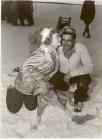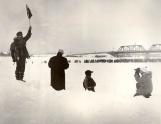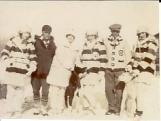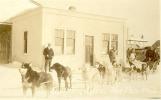14
Differences between the Early and Later Sled Dog RacesEarly Sled Dog Races
-Used old fashion toboggan until 1920
-Non-stop race from The Pas to Flin Flon and return
-Mushers broke their own trails from The Pas to Flin Flon and back and needed to carry all their own food
-Winner had to announce his arrival - due to the length of the course over difficult terrain, the winner could finish the race at any time of the day or night
-Dogs were kept outdoors in the bush, usually at Grace Lake, east of The Pas
Later Sled Dog Races
-Alaska Hitch introduced by Walter Goyne in 1920 used exclusively ever since
-150 mile race completed over 3 days (50 miles each day) - today 35 miles each day [2007]
-Local Kinsmen club breaks trails and mushers stay in local motels and are not required to carry their own food
-Spectators are present during the finish of the race which occurrs during the daytime
-dogs kept in individual compartments of trucks away from the elements
16
Musher and Fur QueenCirca 1943
The Pas, Manitoba, Canada
 Credits:
Credits:Sam Waller Museum Collection
Bert Hutton
Tanis Asselstine
18
The Pas Derby 1928Circa 1928
The Pas, Manitoba, Canada
 Credits:
Credits:Sam Waller Museum Collection
Stewart McLean
19
Sled Dog RacesThe sled dog races originally started in front of the Opasquia Hotel, now The Pas Center Hotel, on Edwards Avenue. From there the teams would race onto the Saskatchewan River through the Big Eddy Reserve and travel all the way to Flin Flon and back. As the race evolved, the teams would start along the western highway from The Pas towards Saskatchewan. Spectators could drive along the highway to witness portions of the race. However, when the ice wasn't safe, the race would start on Halcrow Lake in The Pas, which has now become the regular starting point for the race.
After the official inauguration of the Northern Manitoba Trappers' Festival in 1948, local service groups prepared the dog trails for the race. Much work was required in preparing the trails. Portions of the trail traversed private lands. Agreements were required with landowners, and the design of the trail had to avoid the property of others. The trails were groomed by building up the base of hard-packed snow with power toboggans and bombardiers, and then 'dragging it'. It was a labour intensive process. The starting line was set up with a portable office booth. Many dedicated people have been setting dog trails for years.
20
Sled Dog RaceCirca 1949
The Pas, Manitoba, Canada
 Credits:
Credits:Sam Waller Museum Collection
Gene Germain
21
Emile St. Godard and Fur QueenCirca 1929
The Pas, Manitoba, Canada
 Credits:
Credits:Sam Waller Museum Collection
Joan Bidinosti
22
The DogsTrappers were very proud of their dogs. Many sled dogs had strains of timber wolf in their bloodlines. While this made them somewhat more difficult to handle, it produced a hardier animal that could travel long distances through the wilds on a minimum of food. An outstanding team that showed promise of speed was often entered in the sled dog races. The dogs used in these original races were actual working trapline dogs, that traveled in the bush and across muskegs with the trapper tending his lines. They were well-conditioned workers, and often produced amazing results in the races. To keep them healthy, trappers had to ensure a steady supply of food, usually in the form of fish and/or other wild game.
The dogs used for hauling sleds were originally bred from Siberian and Malamute Huskies. Over time, the breeds changed. As snow machines became more prevalent, dogs were no longer needed to haul trapline sleds. The early dogs were specifically bred for strength and endurance in order to break trails and haul large loads. As sled dogs became used more exclusively for racing, speed became the critical factor, and dogs were crossbred with hounds for increased speed and agility. Modern sled dogs are often bred exclusively for racing and weigh in at 20 - 25 pounds.
23
Emile St. Godard and Fur Queen CandidatesCirca 1929
The Pas, Manitoba, Canada
 Credits:
Credits:Sam Waller Museum Collection
Joan Bidinosti
24
Care of Sled DogsCompetitive sled dogs are among the best housed, trained, fed, and conditioned canine athletes in the world. They receive veterinary care that is comparable to the medical care offered to Olympic athletes. Each dog on the team plays an important individual role, so every effort is made to keep each one in top physical and mental condition in order to maintain peak performance.
All rules governing sled dog competition - whether it is team racing, skijoring, weight pulling, or cross-country trekking - are designed to maintain the well-being of the dogs as a top priority and, secondly, to provide fair competition. All competitors belong to a dedicated sled dog organization, each created to promote humane contests where "the best team wins".
Nowadays, the dogs are smaller and generally have short hair so they spend little time outside of their warm kennels before the start of the race. It is not uncommon to see the dogs wearing small booties to protect their feet from rough ice patches. At the end of the race, the dogs are watered, fed and rubbed down for the musher to ensure they have not sustained injuries in the day's race. This also gives the musher a chance to rub down his dog's sore muscles - a form of athletic massage.
25
Edwin Lambert and DogsCirca 1949
The Pas, Manitoba, Canada
 Credits:
Credits:Sam Waller Museum Collection
Gene Germain
27
The MusherThe "ultimate" leader of the dog team is the human being on the runners of the sled - the one who cares for the dogs, protects them, houses them, feeds them, and best of all, takes them out as a team for training and running races. A team of dogs is much stronger than any single person can control physically, but by being fair, consistent and considerate, the driver earns the respect of his dogs, who willingly respond to his every command. Early on in the dog derbies, many of the mushers did not own their teams. To race their teams, owners sponsored the drivers of the day.


